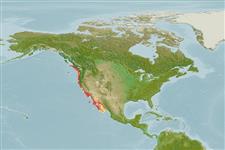分类 / Names
俗名 | 同种异名 | Catalog of Fishes(属, 种) | ITIS | CoL | WoRMS | Cloffa
Teleostei >
Clupeiformes (Herrings)
鯡目 (Herrings) >
Engraulidae (Anchovies)
鯷科 (Anchovies) > Engraulinae
Etymology: Engraulis: Greek, eggraulis, -eos = anchovy (Ref. 45335); mordax: Genus name from the Greek 'engraulis' meaning anchovy; species name from the Latin 'mordax' meaning biting (Ref. 27436).
More on author: Girard.
Environment: milieu / climate zone / depth range / distribution range
生态学
海洋; 深度上下限 0 - 310 m (Ref. 96339), usually ? - 219 m (Ref. 54433). 亞熱帶的; 51°N - 21°N, 131°W - 108°W (Ref. 54433)
Northeast Pacific: northern Vancouver Island south to Cape San Lucas, Baja California, Mexico. Two subspecies recognized: Engraulis mordax mordax from British Columbia to Baja California and Engraulis mordax nanus in Bays of California.
東北太平洋: 溫哥華島北部南至岬桑河盧卡斯,墨西哥的下加利福尼亞。 二個亞種辨認出: 在加州的海灣中的從卑詩省到下加利福尼亞的 美洲鯷〔Engraulis mordax〕 mordax 與 美洲鯷〔Engraulis mordax〕 nanus。
Length at first maturity / 大小 / 重量 / 年龄
Maturity: Lm 9.6 range ? - ? cm
Max length : 24.8 cm SL 雄鱼/尚未辨别雌雄; (Ref. 27436); common length : 15.0 cm TL 雄鱼/尚未辨别雌雄; (Ref. 9988); 最大体重: 68.00 g (Ref. 56527); 最大年龄: 7 年 (Ref. 6884)
背棘 (总数) : 0; 背的软条 (总数) : 14 - 19; 臀棘: 0; 臀鳍软条: 19 - 26; 脊椎骨: 43 - 47. Snout quite sharply pointed; maxilla moderate, tip sharply pointed, reaching to or almost to hind border of pre-operculum, projecting well beyond tip of second supra-maxilla; tip of lower jaw below nostril. gill rakers slender, long; absent on hind face of third epibranchial. Anal fin origin under about base of last dorsal fin ray. A silver stripe along flank, disappearing with age.
吻相当非常尖; 颚骨中等的, 顶端非常尖的, 延伸到或几乎到前鳃盖的后部边缘, 突出的越过第二个上颚骨的顶端; 在鼻孔之下的下颌的顶端。 鳃耙细长的, 长的; 在第三个上鳃骨的后部面貌上不存在。 在大约最后背鳍鳍条的基底下面的臀鳍起源。 一条银色的斑纹沿着侧面,随着年龄而消失。
Usually found in coastal waters within about 30 km from shore, but as far out as 480 km, forming large, tightly packed schools. Enters bays and inlets. Feeds on euphausiids, copepods and decapod larvae, both by random filter-feeding and by 'pecking' at prey. Oviparous, epipelagic batch spawner (Ref. 6882). Spawns throughout the year, peaking once (Ref. 6882). Processed into fishmeal, used as bait for tuna, occasionally canned (Ref. 9298).
大约在距离海岸 30 公里之内的通常发现于沿岸水域, 但是远达 480 公里, 形成大的, 紧紧地包装了鱼群。 进入湾内。 吃磷虾, 桡脚类的动物与十足目幼生, 两者都被随机滤食与被 '以喙啄' 在猎物。 卵生的,表层带分批产卵者.(参考文献 6882) 产卵全年度, 到达高点一次。 (参考文献 6882) 对于鲔鱼加工成鱼粉 , 用来当鱼饵了, 偶然地装于罐头。 (参考文献 9298)
Spawns from British Colombia south to Magdalena Bay, Baja California, but most abundantly between Point Conception and Point San Juanico. There are two major spawning areas: 1) off southern California and northern Baja California and 2) off central and southern Baja California. Oviparous (Ref. 35602). Spawns either in inlets or offshore, throughout the year but mainly in winter and early spring, depending on hydrological conditions (preferably at 10 to 23.3° C in upper water layers and around 22.00 hours). Spawning occurs at night between 2000 and 0400 hour (Ref. 6882).東北太平洋: 溫哥華島北部南至岬桑河盧卡斯,墨西哥的下加利福尼亞。 二個亞種辨認出: 在加州的海灣中的從卑詩省到下加利福尼亞的 美洲鯷〔Engraulis mordax〕 mordax 與 美洲鯷〔Engraulis mordax〕 nanus。
Whitehead, P.J.P., G.J. Nelson and T. Wongratana, 1988. FAO Species Catalogue. Vol. 7. Clupeoid fishes of the world (Suborder Clupeoidei). An annotated and illustrated catalogue of the herrings, sardines, pilchards, sprats, shads, anchovies and wolf-herrings. FAO Fish. Synop. 125(7/2):305-579. Rome: FAO. (Ref. 189)
人类利用
渔业: 商业性; 诱饵: usually
工具
特别资料
下载 XML
网络资源
Estimates based on models
Preferred temperature (Ref.
123201): 7.6 - 14.9, mean 9 °C (based on 55 cells).
Phylogenetic diversity index (Ref.
82804): PD
50 = 0.5020 [Uniqueness, from 0.5 = low to 2.0 = high].
Bayesian length-weight: a=0.00550 (0.00348 - 0.00867), b=3.08 (2.94 - 3.22), in cm total length, based on LWR estimates for this species & Genus-body shape (Ref.
93245).
营养阶层 (Ref.
69278): 3.1 ±0.28 se; based on food items.
Generation time: 2.3 (1.6 - 2.6) years. Estimated as median ln(3)/K based on 17
growth studies.
回复力 (Ref.
120179): 中等的, 族群倍增时间最少 1.4 - 4.4年 (rm=0.36; K=0.2-0.6; tm=1-4; tmax=7; Fec=4000).
Prior r = 0.50, 95% CL = 0.33 - 0.75, Based on 2 data-limited stock assessments.
Fishing Vulnerability (Ref.
59153): Low vulnerability (24 of 100).
Climate Vulnerability (Ref.
125649): Low vulnerability (22 of 100).
Nutrients (Ref.
124155): Calcium = 159 [69, 355] mg/100g; Iron = 1.23 [0.60, 2.84] mg/100g; Protein = 18.6 [17.4, 19.9] %; Omega3 = 0.841 [0.514, 1.405] g/100g; Selenium = 20.5 [9.8, 42.9] μg/100g; VitaminA = 13.9 [3.2, 56.6] μg/100g; Zinc = 1.01 [0.65, 1.56] mg/100g (wet weight);
